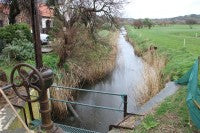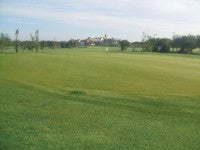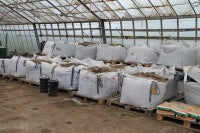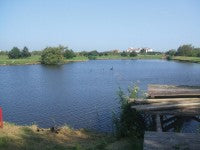Guernsey - Making Waves
"We have been known to row a boat across six fairways without touching dry land"
 Martyn Savident is Course Manager at La Grande Mare Hotel Golf and Country Club in Vazon Bay, Guernsey. He began his greenkeeping career in 1980 at the St Pierre Park Hotel, a 9 hole, par 3 course designed by Tony Jacklin. By 1987 he had become head greenkeeper.
Martyn Savident is Course Manager at La Grande Mare Hotel Golf and Country Club in Vazon Bay, Guernsey. He began his greenkeeping career in 1980 at the St Pierre Park Hotel, a 9 hole, par 3 course designed by Tony Jacklin. By 1987 he had become head greenkeeper.
Three years later Martyn was offered the position of head greenkeeper at the yet to be constructed course at Vazon Bay. Designed by Hawtree Golf, originally as a 9-hole, the plan soon changed to become a full 18 holes. Martyn was able to oversee the construction of all the push up greens, four of which are double greens (18 holes on 14 greens), excavations of the lake and tee constructions. The course was officially opened in March 1994.
The course is situated on the west coast of Guernsey and actually sits below the high water mark by about 15 feet. The name, translated from French, means The Great Marsh or The Big Water, depending on dialect. Understandably, drainage is never far from their minds!
 The complex is the largest privately owned piece of land on the island and now covers 120 acres.
The complex is the largest privately owned piece of land on the island and now covers 120 acres.
Even with nearly thirty years of experience Martyn says he is still learning. "There is always something new to get my head round - chemicals, soil amendments, machinery improvements or new thoughts on turf management techniques. Networking has always been an important part of the job. But, living on an island with only a few other lads to call on, it's not easy. So, I have found the message boards and forums on the Pitchcare and BIGGA websites very useful."
Martyn always works to a plan, whether it is trying to increase the finer grasses - bents and fescues - or improving the presentation of the course. "All plans must end up at the same point," he says, "Improving the experience of the golfing customer. That is what I see as our main purpose in the job."
"Alan Fox is my assistant, he has been with me for seven years. I've got two other full time greenkeepers, Justin Dowington and Paul McGahy, and an almost full time mechanic, Geoff Duquemin, who works thirty hours a week and has been part of the team for six years."
"I call in extra labour as required during the growing season, just to keep up with rough cutting, which takes up to forty hours a week, and tees and fairway divoting, to which twenty-four hours are allocated. I also take in a student from a French horticultural/agricultural college for between four to eight weeks each year."
Drainage

"With the course being below the high water mark, flooding is a problem and drainage essential. There are a network of ditches - douits, pronounced 'dwee' in the local patois - that criss-cross the fairways. These carry the water, that enters through the boundaries at around twenty different places, to one outlet that runs under the coast road through a three foot pipe to the beach."
"This pipe has a non return valve halfway through that closes when the tide rises - there is over ten metres height difference from the highest and lowest tides - and the inward pressure of the sea is higher than the outward pressure of the water in the drainage ditch."
"The non return on a high tide can keep the gate closed for up to six hours and, with two tides a day, this is always a problem during winter months. This can become a problem when high tides and rain cause the ditches to fill and, on occasions flow over the fairways. We have been known to row a boat across six fairways without touching dry land."

"To help control the flooding, a pump is positioned near the beach that lifts water from the main ditch to the beach up a ten inch suction pipe to the pump ten feet above. The water is then pushed along a further sixty feet, and up another five feet, to the coast road drains where it then passes under the road to an outlet just above high tide mark to the beach."
"During the past winter the pump ran from late November to early January, non-stop, pumping 2,000,000 gallons a day, using around four litres of fuel per hour - thank God for red diesel. The pump can be manually controlled or put on a float switch. We keep it on float most of the time."
"On the outlet pipe, on the course side, there is a gate valve that can be lowered in times of drought to keep water in the ditches and raise the water table to keep the fairways green. But, this would have to be carefully monitored, and we have not needed to resort to this yet."
Design
"Originally designed by Fred Hawtree, as a 9 hole, par 35, it was subsequently extended by his son, Martin, to an 18 hole, par 64. It is a very challenging course with ponds, lakes and open ditches in play on all but one of the holes. Even from this tee though, a shanked ball can find water! Martin Hawtree still visits us regularly, the last time was in February of this year."
"All of the greens and tees were constructed from the native soil - a mixture of peat, sand and clay - dug out when creating the lakes and realigning and widening the ditches."
"Over 17,000 trees have been planted. There is quite a contrast in environment around the course, from exposed coastal areas to sheltered woodland further from the sea. We have had to put various species around the course, most of which have been taken as cuttings and grown on by the staff. The holes that are near the sea have been planted up with Tamarix that are hardy and thrive on the west coast of the island. In the wetter areas we have planted various willow varieties - golden, weeping, tortured and red. We've also planted poplars and alders that also don't mind wetter conditions, and we have established areas of pine, hawthorn and oaks."
Agronomy
"With so many differing soils on site I employ the services of agronomist, George Shiels, who has been advising the club for ten years. During his visits I walk the course with him and discuss programmes of work, take a number of core samples and agree a way forward."
Budgets
"Living on an island has one big disadvantage - the cost of carriage. All course accessories - flags, sticks, tee markers, signs, hole cutters, cups etc. - are ordered in one lot, so I have to ensure that everything is covered."
 "To get goods to the island costs, on average, £60 per tonne. Topdressing has just jumped to £100 per tonne, forty bags of fertiliser now costs an extra £60 to get here. In the present financial climate it is now costing us much more for less. That is why I try to get everything for the year in at one go and store it in the shed (greenhouse)."
"To get goods to the island costs, on average, £60 per tonne. Topdressing has just jumped to £100 per tonne, forty bags of fertiliser now costs an extra £60 to get here. In the present financial climate it is now costing us much more for less. That is why I try to get everything for the year in at one go and store it in the shed (greenhouse)."
"Even visits from Martin Hawtree and George Shiels have to be budgeted for; tickets and other costs can amount to over £250!"
"I try and keep the total running costs to around £250,000 per year. The largest cost is the staff wages at £125,000. Machinery leasing and repairs costs around £35,000 and course consumables - fertiliser, seed, topdressing and pesticides - between £15-18,000. Drainage and flood control will usually cost around £12,000."
Maintenance Regimes
"I try to keep applications of fertiliser as low as possible on the greens, concentrating on applying double the amount of potassium as nitrogen, which we try to keep below 70kg N per hectare per year."
"With our warmer climate, we can apply a tonic to the greens in early March (8:0:0 at 10g/m), before the first application of wetter H2Pro at 25 l/h, and then every six weeks at 20l/h. This will be closely followed by Scotts Blade soil supplement at 40l/h and a first application of PrimoMaxx at 0.05 l/h followed by monthly applications at 0.04l/h."
"I try to get a head start in spring, with my first hollow coring work straight after our first major tournament, which is usually on Easter Monday. We core with 12mm tines and clear all the greens, first with the front nine closed and, later in the day, we start on the back nine and finish mid-morning the following day."
"The greens are overseeded with Manor and Heriot browntop bent from Johnsons Seeds. This is broadcast with a pedestrian spreader at 5-6gm per square metre (about 180 kilos for this year)."
"Each green is then sarrel rolled and topdressed with around one tonne of 90/10 Wessex topdressing brushed in with a Sisis Oscar oscillating brush. This will be followed with vibratory rollers for the next couple of days."
"The greens are then topdressed on a monthly basis, at half rate, until another hollow coring is completed in August."
"The height of cut remains at 6mm until mid to late April, and is then lowered to 4mm over a three week period. We never go much below 4mm during the season and, for our big tournaments, we double cut and roll depending on conditions."
"A number of other fertiliser products are used during the season that include a light spring and summer granule, but mostly High K and Effect Iron liquids to increase stress tolerance and improve colour."
"The tees are hollow cored (very shallow) in March and overseeded with Johnsons Teemaster, and topdressed with the same 90/10 mix as the greens. They are fed twice a year, first in early April with Scotts Sierrablen Turf 28:5:5, which keeps them looking good for the season, and then, in Autumn, Sierrablen Mini 0:0:37 sees them through the winter."
"The fairways don't get fed at all during the winter months, as we get flooded right across the course from heavy rain, and when the sluice gate is closed by the high tides. And, because all the surrounding hills are mostly farmland, the nutrients that are in the floodwater, will look after the fairways - help from Mother Nature."
Disease management
"Because of the low lying land, and the amount of water that passes through the course, plus the proximity to the coast with mist and fog, it is essential to get the greens dry as soon as possible in the morning. This is done with a 3 metre 'Big Dewey' brush or the tractor mounted Sisis Oscar brush."
 "Fusarium and anthracnose will always raise its head when the right conditions prevail, and I've also seen some dollar spot in recent years. However, with the development of Heritage, Banner Maxx and Instrata, disease control is getting easier and disease scarring is kept to a minimum using these products."
"Fusarium and anthracnose will always raise its head when the right conditions prevail, and I've also seen some dollar spot in recent years. However, with the development of Heritage, Banner Maxx and Instrata, disease control is getting easier and disease scarring is kept to a minimum using these products."
Aeration
"Aeration is a continuous programme. All the greens are solid cored with 12mm tines from 130mm depth down to 250mm depth each month with the Wiedenmann."
"The greens are hollow cored, seeded and topdressed twice a year, in spring and autumn. They also get Earthquake 'Tremored' to a maximum depth of 250mm. This leaves a continual slit right across the green from high side to lower. During the wetter months we use a Sisis outfield slitter with seven inch knives every week, weather permitting, and supplement this with the Greentek sarrel rollers on our old Ransomes 160D."
"Tees are also solid cored with the Wiedenmann, fitted with 16mm solid tines, and this is carried out every two months, if possible. We only hollow core them with jumbo tines (very shallow) when overseeding."
"The fairways also get to see both the Wiedenmann with the large solids twice a year and also the 'Tremor' in the spring and autumn."
Machinery
"Most of the gear in the shed has been purchased, with the exception of the cutting fleet and one of the Gators. These are secured on a three-year operator's lease. With John Deere being awarded the latest five-year deal, which will include a new bunker rake and an extra buggy, we have found this a much better way to replace the fleet and easier to maintain." 
"We have also invested in a Hunter Juno cylinder grinder, and myself and Geoff have been trained how to use it. Keeping the mowers sharp on a regular basis will certainly help with the presentation of the course."
At various times of the year La Grande Mare must be a 'mare' to work with, both logistically and from what Mother Nature throws at it. It is good to see Martyn and his team committed to the highest standards possible in such difficult circumstances. They are to be applauded.
New John Deere equipment for the club
What's in the shed?
Guernsey used to be famous for its tomato exports and, for nearly one hundred years, the tomato was king.
In the late 1960s nearly half a billion tomatoes were picked and exported to England. Each one of those had to be handpicked, packed and shipped out.
Now, the tomato industry is all but gone, but the greenhouses have not. La Grande Mare use one as their workshop, and here's what's in it:
1x JD 3235 fairway mower
1 x JD 1565 front deck mower
2 x JD 2500B greens mowers
1 x Greentech vibratory rollers
2 x JD gators, one 6 wheeler
1 x JD 500 triple tees and aprons
1 x Toro Workman
1 x Toro 2500 trailed topdresser
1 x Toro Sand Pro
1 x Ransomes 180D with sarrel roller and verticut units
1 x Massey Ferguson 360 tractor
1 x Kubota STA35 compact tractor with front loader and mid mount deck
1 x Case International 255 compact tractor
1 x Sisis Variseeder
1 x Sisis oscillating brush
1 x Sisis outfield slitter
1 x Wiedenmann Terraspike GXi
1 x Earthquake Tremor
1 x 3 tonne Warwick trailer
1 x Team Sprayer - 300 litres
